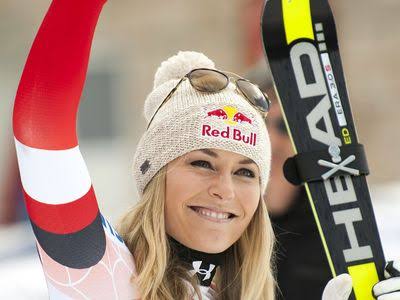
Lindsey Vonn, one of the most decorated alpine skiers of all time, made headlines recently with her attempt to return to the World Cup circuit at the age of 40. After officially retiring in 2019, Vonn’s comeback has sparked a heated debate within the skiing community: Is 40 too old for a comeback in such a physically demanding sport? While some fans and analysts are thrilled to see the legendary athlete back on the slopes, others are questioning whether her decision undermines the risks and challenges faced by older athletes in high-performance sports.
The Return: Vonn’s Performance in the 2024 World Cup
Vonn’s return to competitive skiing in the 2024 World Cup was met with much anticipation, given her impressive legacy of 82 World Cup victories, an Olympic gold medal, and a history of overcoming injuries. However, the reality of her performance was far from the dominant form that fans had come to expect from the champion. Vonn finished 14th in her return race—an unexpected result that raised more questions than answers about her current standing in the sport.
While finishing 14th might not be disastrous for many athletes, for someone of Vonn’s caliber, it was seen by some as a disappointing result. After all, Vonn had set a high bar during her illustrious career, breaking records and consistently standing on podiums. The fact that she is now struggling to even make the top 10 has sparked a conversation about the natural decline in performance with age, even for an athlete as experienced and skilled as Vonn.
The Age Debate: Can Athletes Truly Make a Successful Comeback After 40?
At 40 years old, Lindsey Vonn is no spring chicken in the world of professional skiing. The sport is known for its punishing demands on the body, with athletes routinely facing risks of injury and the pressure to perform at peak physical condition. Skiing requires not only immense skill but also strength, speed, and the ability to withstand the kind of physical stress that only comes with years of intense training and competition. Vonn’s career was marked by frequent injuries, including multiple knee surgeries, a torn ACL, and a fractured arm, which led to her eventual retirement.
Skeptics argue that at 40, Vonn is pushing the limits of what is physiologically possible. The aging process naturally affects the body’s ability to recover, build strength, and maintain the same level of agility and speed. For a sport like skiing, where split-second decisions can make the difference between a podium finish and a catastrophic crash, these physical realities cannot be ignored. Many critics contend that Vonn’s decision to return to World Cup racing risks her health and may tarnish her legacy as a champion if she cannot perform at the elite level she once did.
On the other hand, Vonn’s fans point to her unparalleled experience, technical skill, and mental toughness as factors that could still give her an edge over younger competitors. Despite the physical toll her body has endured over the years, Vonn has proven herself to be a fighter—returning from injuries that many thought would end her career. Some believe that Vonn’s comeback, even at 40, could serve as a testament to the power of determination and grit, regardless of age.
The Real Cost of a Comeback: Health and Legacy
One of the major concerns about Vonn’s return to skiing is the potential toll on her health. Skiing is an inherently dangerous sport, and with age, the risk of injury increases exponentially. Vonn herself has spoken openly about the physical pain she endured during her career and how her body was often pushed to the brink. The idea of returning to the slopes, where crashes and injuries are common, raises questions about her long-term health and whether the glory of one more race is worth the potential consequences.
Moreover, Vonn’s legacy could be at stake. She is already one of the greatest skiers of all time, and her decision to return might risk overshadowing her historic achievements. If she continues to fall short of expectations and doesn’t recapture her former form, some may argue that her comeback could diminish the image of the athlete who once dominated the sport. Vonn’s name has become synonymous with excellence in skiing, and tarnishing that reputation could be a far worse outcome than gracefully remaining retired.
The Psychological Aspect: Why Do Athletes Return?
Beyond the physical concerns, the psychological factors behind Vonn’s decision to return are worth considering. Many athletes struggle with the idea of retirement, as it forces them to leave behind a life of competitive passion and focus. For Vonn, skiing was her entire world for decades, and the notion of stepping away completely may have been difficult to accept.
Athletes often experience an overwhelming desire to return to competition, not only to prove something to themselves but also to regain the sense of purpose that retirement can take away. In Vonn’s case, the comeback might not just be about winning medals or podiums but about reaffirming her identity as an athlete who can overcome obstacles. Whether that is a healthy motivation or a risk to her well-being is a topic that only she can truly understand.
Conclusion: A Risk Worth Taking?
Lindsey Vonn’s return to World Cup skiing at the age of 40 is both inspiring and controversial. While her attempt at a comeback is commendable, the questions about her ability to reclaim her former dominance in such a physically demanding sport are valid. As she races down the slopes once again, Vonn will undoubtedly have to balance her ambitions with the reality of what her body can withstand. Only time will tell if her return will be seen as a triumphant defiance of age or a cautionary tale about the cost of chasing past glory. Regardless of the outcome, Vonn’s legacy as one of the greatest alpine skiers in history is already secured, and any further chapters she writes will only add complexity to her storied career.






